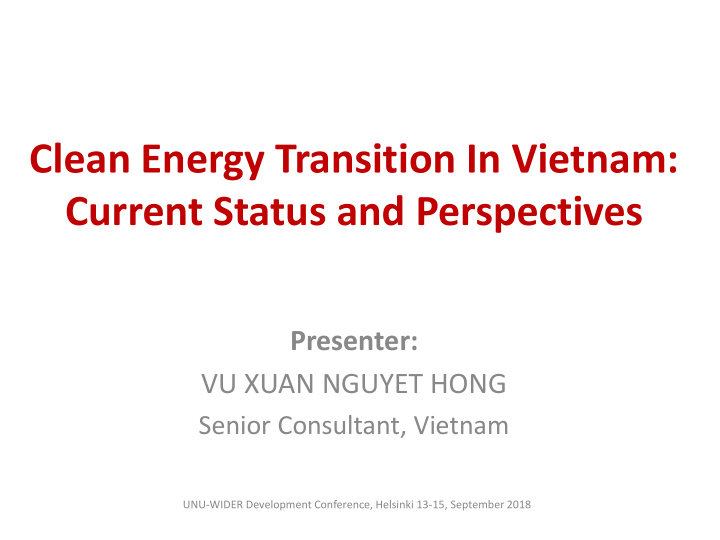



Clean Energy Transition In Vietnam: Current Status and Perspectives Presenter: VU XUAN NGUYET HONG Senior Consultant, Vietnam UNU-WIDER Development Conference, Helsinki 13-15, September 2018
Contents ➢ Vietnam’s context toward clean/renewable energy transition ➢ The drivers of clean/renewable energy transition in Vietnam ➢ The Future of Clean Energy in Vietnam: overcome challenges for RE transition
1. Vietnam’s context toward clean/renewable energy transition • High economic growth in Vietnam has associated with a high growth of energy consumption: 1.62 time higher between 2001-2015 on average. 20 Growth of electricity consumption per capita 18 16 Growth of GDP in PPP per capita 14 12 10 8 6 4 2 0 2001 2002 2003 2004 2005 2006 2007 2008 2009 2010 2011 2012 2013 2014 2015 Source : calculated from World Bank’s and EIA data • But, the trend of this correlation tends to decrease: 2001-2005: 1.76 times; 2006-2010: 1.69 times; 2011-2015: 1.35 times
1. Vietnam’s context… (2) • Energy development in the country has been largely depended on fossil fuels and hydro-power: In 2015 , their shares recorded at 70.5%. Non- hydro Renewable energy presents a very limited share : 0.4%. Other (diesel, small HH, biomass, waste to Wind, 0.35% Import, 1.28% energy), 5.14% Solar, 0.01% Oil, 2.24% Natural gas, 20.48% Hydro (large H), 37.47% Coal, 33.04%
1. Vietnam’s context… (3) • The revised PDP VII (2016) has planned to increase the share of renewable energy sharply, from 0.4% now to 7% by 2020 and 14% by 2030. 2030 2020 Natural gas Natural gas Coal Coal 1.20% Nuclear Nuclear 7.10% 2.40% 4.63% 14.70% 1.42% 1.33% 14.90% 7.15% Hydro (large H) Hydro (large H) 9.27% Oil Oil 16.90% Solar Solar 30.10% Wind Wind 42.70% 42.60% 3.55% Other (diesel, small HH, Other (diesel, small HH, biomass, biomass, waste to energy) waste to energy) Import Import However, share of coal power is expected to be as high as 42.6% in 2030.
Targets set for RE development Wind Solar Hydro MW RE Non-RE 30000 TWh 1200 27800 24600 25000 1000 21600 20000 800 599 17000 15000 600 12000 10000 400 395 6000 452 5000 4000 200 165 2000 108 800 850 186 140 5 101 58 0 0 2016 2020 2025 2030 2015 2020 2030 2050 Source: Strategy of RE Revised EDP VII (2016) development (2015)
RE transition dilema: ✓ On one hand, Vietnam’s ✓ On the other hand, VN has Revised PDPVII planned 42 GW high potential for developing of new coal capacity (22 coal- different types of RE which fired plants) currently has not been exploited yet. ✓ If all these coal-fired power plants were built, VN would 8000 have the fourth largest 7000 Potential number of coal-fired power capacity 6000 plants in the world 5000 ✓ Energy development based on 4000 fossil fuels would lead the 3000 economy to environmental 2000 pollusion risks and increase of 1000 CO 2 emission 0 WIND ENERGY BIOMASS URBAN TIDAL ENERGY GEO-Thermal WASTE
2. The Drivers of Clean/Renewable Energy Transition in Vietnam Global context: • COP 21 and commitments to reduce CO2 emission • Reduction of global financing for coal-fired projects • Costs for investing in RE droped by 10% last two years- installed RE capacity increased sharply and steadly. • Technology advancements – various RE technology solussions National context • Policies to promote non-hydro RE were introduced (strategy for RE dev, several incentives introduced to RE investment projects) • Increased public awareness of the environmental risks from coal-fired power plants – created pressure for RE transition
2. The Drivers… (2) • More difficult to borrow ODA & international development partners for coal-fired power investment • Energy market reforms: Electricity price reform, competitive retail power market by 2030, FIT mechanism, • Greater interest of RE investors and international development communities
Some evidence • National context : Policies to promote non- hydro RE – RE development strategy to 2030 and vision to 2050 (increase installed and production capacity of RE, increase share in energy sector; technology advancements…etc.) – Policy mechanisms to promote non-hydro RE investmnt (wind, solar, bio-fuel..) in term of finance, tax, FIT, land preference
Increased public awareness of the environmental risks from coal- fired power plants – created pressure to move toward RE transition • Development partners supports to increase awareness on RE dev. • Campains by the social communities & experts (Green ID, REN 21), people living close to the coal- fired power plants (about air pollusion issues);
• The voices of development partners on Vietnam’s coal-fired power development plan
3. The Future of RE in Vietnam: • Now is the time for RE transition in VN since we have several conditions/opportunities: – Government laws and policies are in place; – Pressures are enhanced both externally and internally (as mentioned) – Costs of RE investment vs. coal-fired power become more competitive
3. The Future… (2) However, VN needs to overcome challenges for RE transition (at least in a short run) • Project development capacity • Data/information availability/ accessibility Technical • Dependence on foreign technology • Infrastructure readiness • Low electricity price • Large investment required Non- • Need national planning for RE in place technical • More effective policy/mechanism
• What should be done ? – More strong commitments and policy will from energy policy-makers. – The PDP VII needed to be revised in near future to meet the RE transition tendency (higher share of RE) – RE transition and energy efficiency approach should be hand in hand (the later has very high potential in VN). – Make sure the energy sector reforms and RE policies implemented effectively in practice.
Thank you for your attention
Recommend
More recommend